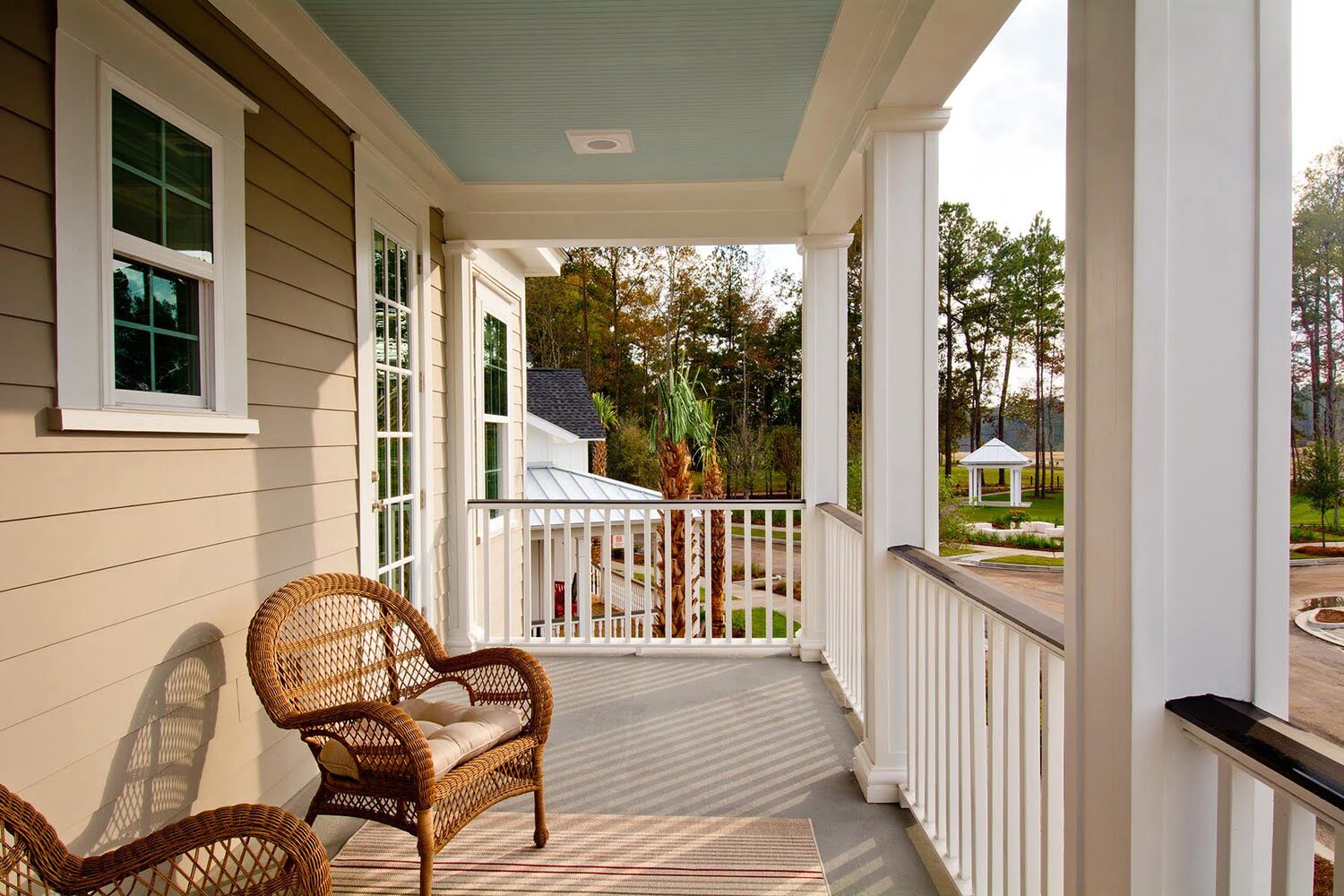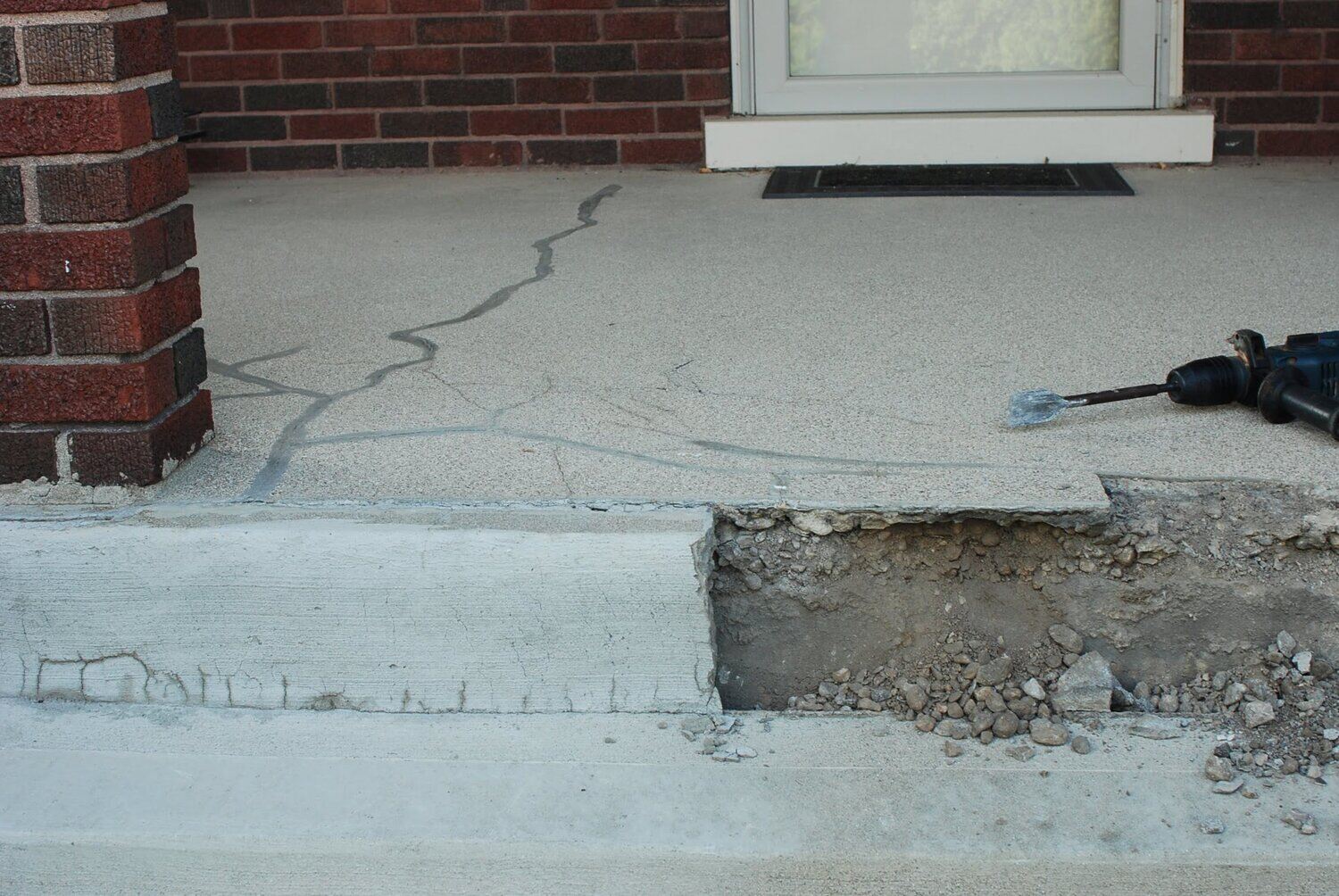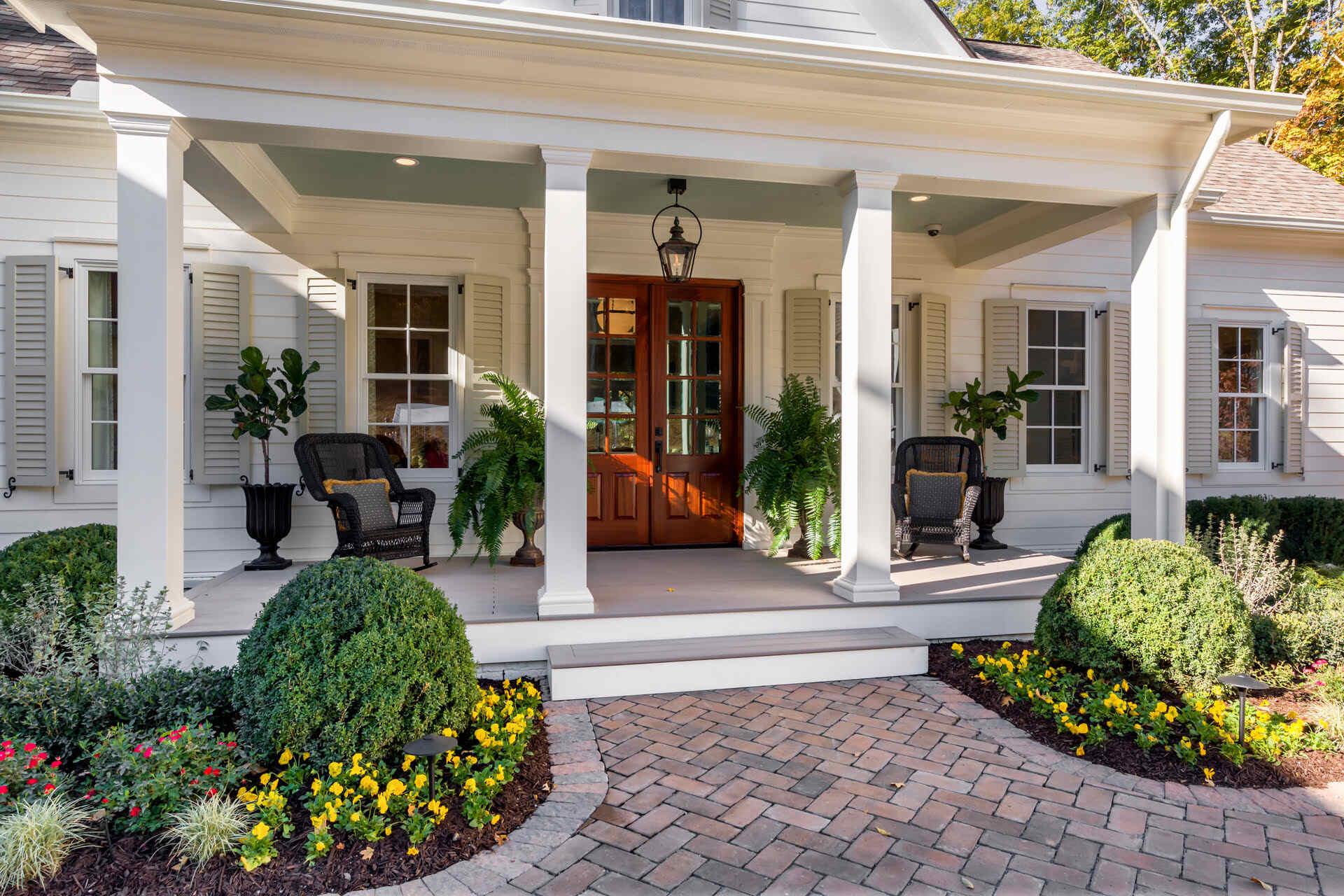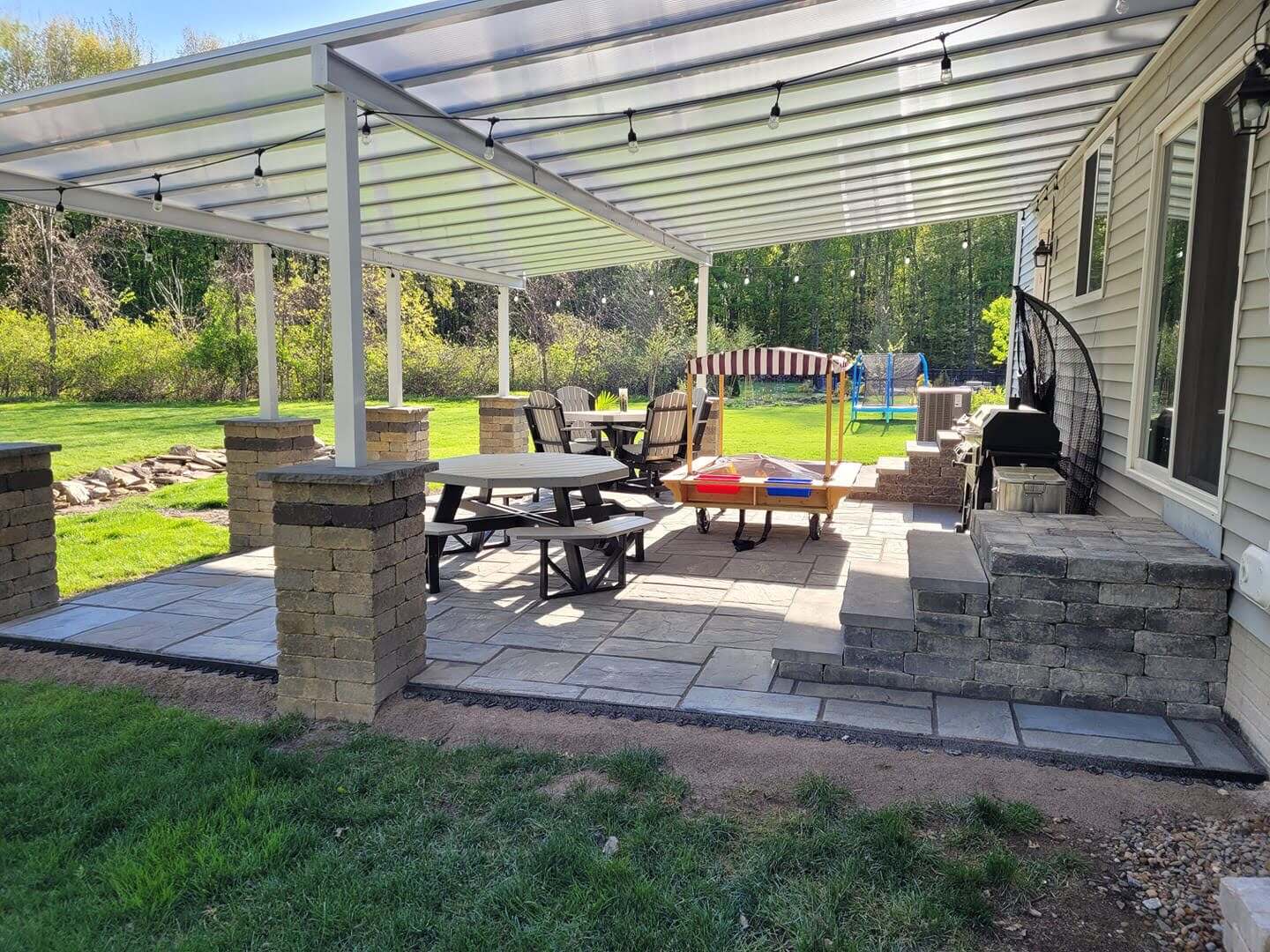

Articles
How Wide Should A Front Porch Be
Modified: May 6, 2024
Discover the ideal width for a front porch in our comprehensive articles. Learn how to create a welcoming entrance with the perfect dimensions.
(Many of the links in this article redirect to a specific reviewed product. Your purchase of these products through affiliate links helps to generate commission for Storables.com, at no extra cost. Learn more)
Introduction
When designing or renovating a house, the front porch plays a vital role in creating a welcoming and aesthetically pleasing entryway. It serves as a transition zone between the interior and exterior of the home and can provide a space for relaxation, socializing, or simply enjoying the outdoors.
One crucial aspect to consider when planning a front porch is its width. The width of a front porch has both functional and aesthetic implications that can greatly affect the overall design and functionality of the space. Determining the optimal width requires careful consideration of various factors, including available space, functional needs, and local building codes.
In this article, we will delve into the importance of front porch width and delve into the factors that should be considered when determining the ideal width of a front porch. Whether you are designing a new home or contemplating a porch renovation, this guide will provide you with the necessary insights to make an informed decision.
Key Takeaways:
- The width of a front porch is crucial for functionality and aesthetics, impacting usability, visual appeal, and property value. Careful consideration of available space, functional needs, and local regulations is essential for an optimal design.
- When choosing the optimal front porch width, homeowners should prioritize functionality, visual harmony, and compliance with building codes. Seeking professional advice and envisioning the final result are key steps in making an informed decision.
Read more: How Big Should Porch Columns Be
Importance of Front Porch Width
The width of a front porch plays a crucial role in determining its functionality and aesthetic appeal. It is important to strike the right balance between a porch that is too narrow, which can feel cramped and restrict movement, and a porch that is too wide, which may diminish the visual impact of the home’s facade or waste valuable outdoor space.
One of the key reasons why front porch width is significant is because it affects the usability of the space. A porch that is wide enough allows for comfortable seating arrangements, the placement of furniture, and even the inclusion of decorative elements such as potted plants or outdoor lighting fixtures. Therefore, the width should be considered based on the desired use of the porch, whether it’s intended for simply lounging or for hosting gatherings and social events.
Another important aspect influenced by front porch width is the overall aesthetic appeal of the home. The porch serves as a focal point and can greatly enhance the curb appeal. A porch that is proportionate to the size of the house creates a visually pleasing and harmonious design. On the other hand, a porch that is too narrow can look out of place and make the home appear unbalanced or incomplete.
The front porch width also impacts the flow and functionality of the adjacent spaces. If the porch is too narrow, it may limit the ease of entry and exit from the house, making it difficult for people to pass through comfortably. Additionally, a narrow porch may also restrict the use of the front door, making it challenging to maneuver when carrying large items or furniture in and out of the house.
Furthermore, the width of the front porch can also affect the overall resale value of the property. A well-designed and appropriately wide front porch can significantly enhance the perceived value of a home. It creates a favorable first impression for potential buyers and adds to the overall attractiveness of the property.
Considering the various reasons stated above, it becomes evident why front porch width is a crucial element to take into account when designing or renovating a home. The next section will explore the factors to consider when determining the width of a front porch, helping homeowners make informed decisions that meet their functional and aesthetic needs.
Factors to Consider when Determining Front Porch Width
When determining the width of a front porch, several factors should be taken into consideration to ensure optimal functionality and aesthetics. Let’s explore these factors in detail:
1. Assessing the Available Space
The size and dimensions of the available space are essential factors to consider when determining front porch width. Measure the area where the porch will be constructed or renovated to get a clear understanding of the available width. Take note of any physical limitations, such as the proximity of neighboring properties or existing structures, which may affect the maximum width possible.
2. Analyzing the Functional Needs
Consider how the front porch will be used on a daily basis. Is it primarily a space for relaxation and enjoying the outdoors, or will it also serve as an area for social gatherings and entertainment? Determine the number of people who will typically use the porch at a given time to help determine the necessary width. This will ensure that there is enough space for furniture, seating arrangements, and any desired activities.
Read more: How Tall Should Porch Railing Be
3. Considering Aesthetic Appeal
The width of the front porch should be proportionate to the size and style of the house. Consider the architectural style and overall design aesthetic of the home to ensure that the porch complements the existing structure. A porch that is too narrow or too wide can disrupt the visual harmony of the house. Strive for a porch width that provides a balanced and cohesive look, enhancing the overall curb appeal of the property.
4. Studying Local Building Codes and Regulations
Consult your local building codes and regulations to determine if there are any specific requirements or restrictions regarding front porch width. Some areas have predetermined porch width guidelines to ensure safety and adherence to community standards. Be sure to comply with these regulations to avoid any issues or delays during the construction or renovation process.
By carefully considering these factors, homeowners can make informed decisions about the width of their front porch. Taking the time to evaluate these aspects will result in a porch that not only meets functional needs but also enhances the overall aesthetics of the home.
Assessing the Available Space
Before determining the width of your front porch, it is important to assess the available space to ensure proper planning and utilization. Here are some key considerations when evaluating the space:
1. Measurement
Start by measuring the area where the front porch will be constructed or renovated. Take accurate measurements of the width, depth, and any other relevant dimensions. This will provide you with the baseline information needed to determine the optimal width for your porch.
Read more: How High Should A Porch Light Be Mounted
2. Proximity to Property Lines
Consider the proximity of your property boundaries or neighboring structures. Ensure that you comply with local regulations and setbacks, which may dictate the maximum width allowed for your front porch. It is important to avoid encroaching on neighboring properties or violating any zoning restrictions.
3. Pathways and Entrances
Take into account any pathways or entrances that may be affected by the porch’s width. Ensure that there is enough space for comfortable movement and accessibility. The porch should not obstruct any existing doors or obstruct the flow of foot traffic.
4. Visual Balance
Consider the overall visual balance of your home’s exterior. The porch width should be proportional to the size and scale of the house. A porch that is too narrow might make the front façade appear unbalanced, while a porch that is too wide may overwhelm the overall design. Strive for a porch width that harmonizes with the architectural style and proportions of your home.
5. Outdoor Amenities
If you plan to incorporate additional outdoor amenities, such as seating areas or landscaping features, consider how these elements will fit within the available space. Allow enough room for these amenities while ensuring that they do not overcrowd the porch or obstruct pathways.
By carefully assessing the available space, you can make informed decisions about the width of your front porch. Taking into account measurements, proximity to property lines, pathways, visual balance, and outdoor amenities will help ensure that your porch fits seamlessly within the overall design of your home while maximizing its functionality and appeal.
Read more: How Far Apart Should Porch Spindles Be
Analyzing the Functional Needs
When determining the width of your front porch, it is crucial to consider the functional needs that it should fulfill. This involves understanding how you intend to use the space and what activities will take place on the porch. Here are some factors to consider when analyzing the functional needs:
1. Purpose of the Porch
Consider the primary purpose of your front porch. Will it be primarily used for relaxation, entertaining guests, or as an extension of your living space? Understanding the main function of the porch will help guide your decision-making process regarding its width.
2. Furniture and Seating Arrangements
If you plan on placing furniture or seating on your front porch, you need to ensure that there is ample width to accommodate them comfortably. Assess the size and number of furniture pieces you wish to incorporate, such as chairs, tables, or swings, and allocate enough space to move around them freely.
3. Capacity of the Porch
Consider the number of people you anticipate using the porch at any given time. If you frequently host gatherings or have a large household, you may require a wider porch to accommodate more individuals comfortably. Adequate width will ensure that everyone can move around freely without feeling cramped.
4. Traffic Flow
Think about the traffic flow on your front porch. If the porch serves as a primary entrance or exit point, ensure that there is enough space for smooth and unobstructed movement. Avoid designing a porch that narrows the pathway or causes congestion during busy times.
5. Outdoor Activities
If you plan on engaging in specific outdoor activities on your porch, such as yoga or gardening, consider the additional space requirements. Ensure that there is enough width to accommodate these activities comfortably and allow for movement without feeling constrained.
By analyzing the functional needs of your front porch, you can determine the appropriate width to ensure it serves its intended purpose effectively. Taking into consideration the purpose, furniture and seating arrangements, porch capacity, traffic flow, and outdoor activities will help you create a functional and enjoyable space for yourself and your guests.
Considering Aesthetic Appeal
When determining the width of your front porch, it is essential to consider the aesthetic appeal and how it contributes to the overall design of your home’s exterior. The porch width should complement the architectural style and proportions of your house while creating a visually pleasing and balanced look. Here are some factors to consider when considering the aesthetic appeal:
1. Proportions
Take into account the proportions of your home when determining the width of the front porch. A porch that is too narrow compared to the size of the house may appear disproportionate and visually unappealing. Similarly, an overly wide porch may overwhelm the overall design. Strive for a porch width that harmonizes with the architectural style and scale of your home.
Read more: What Wattage Should A Porch Light Be
2. Visual Balance
Consider the overall balance of your home’s façade when deciding on the porch width. If your home has multiple levels or other architectural elements, ensure that the porch width complements these features. A properly sized porch can enhance the symmetry and visual appeal of your home’s exterior.
3. Architectural Style
Different architectural styles call for varying porch widths. Traditional or Victorian-style homes often have wider porches that span the width of the front façade, while modern or contemporary homes tend to have narrower and more streamlined designs. Take the architectural style of your home into consideration to ensure that the porch width aligns with the overall design aesthetic.
4. Materials and Finishes
Consider the materials and finishes you plan to use on your front porch. The width should be compatible with the materials chosen. For example, a wider porch may lend itself well to stone or brick finishes, while a narrower porch may highlight the beauty of wood or composite materials. The porch width should create a cohesive and visually pleasing composition with the chosen materials.
5. Surrounding Landscape
Take into account the surrounding landscape and outdoor elements when determining porch width. Consider the size and scale of trees, shrubs, or other landscaping features that may enhance or detract from the porch’s visual impact. The porch width should be in harmony with the surrounding environment, creating a seamless connection between the porch and the landscape.
By carefully considering the aesthetic appeal, you can ensure your front porch becomes a visually appealing addition to your home. Consider the proportions, visual balance, architectural style, materials and finishes, and surrounding landscape to create a front porch that enhances the overall beauty and charm of your home.
Read more: What Color Should I Paint My Front Porch
Studying Local Building Codes and Regulations
When designing or renovating a front porch, it is crucial to study and adhere to local building codes and regulations. These codes are in place to ensure the safety, structural integrity, and compliance of the construction project. Here are some key considerations when studying local building codes and regulations:
1. Permit Requirements
Contact your local building department to inquire about the necessary permits required for constructing or renovating a front porch. Different jurisdictions may have varying permit requirements, and it is essential to obtain the appropriate permits before beginning any construction work. Failure to do so may result in legal consequences and delays in the project.
2. Setback and Easement Regulations
Building codes often include setback and easement regulations that determine the allowable distance between structures and property lines. These regulations aim to prevent encroachment on neighboring properties and ensure safety. Be aware of the setback and easement requirements specific to your area to determine the maximum width and placement of your front porch.
3. Design and Construction Standards
Local building codes typically establish design and construction standards that must be followed for porches. These may include requirements for structural integrity, materials, ventilation, railing height, and safety features. Familiarize yourself with these standards to ensure that your front porch design complies with the necessary guidelines.
Read more: How Wide Should A Ladder Be
4. Accessibility and ADA Compliance
If your front porch is intended for public use or if you plan to make your home accessible to individuals with disabilities, you must consider the accessibility requirements set forth by the Americans with Disabilities Act (ADA) or local accessibility codes. These codes may specify minimum widths for wheelchair access, ramp inclines, and other accessibility features.
5. Environmental Regulations
Some regions have environmental regulations that dictate certain construction practices, such as stormwater management, erosion control, or waste disposal. Ensure that your front porch design adheres to these regulations to minimize any negative impact on the environment and comply with local laws.
Studying and understanding local building codes and regulations is essential to ensure compliance and safety during the construction or renovation of your front porch. Consulting with professionals, such as architects or contractors familiar with local codes, can provide valuable guidance and ensure that your project meets all necessary requirements.
Choosing the Optimal Front Porch Width
After considering the various factors discussed earlier, it’s time to make the final decision and choose the optimal width for your front porch. Here are some steps to help you in this process:
1. Evaluate the Space
Review the measurements of the available space and consider any limitations or restrictions imposed by local regulations. Ensure that the porch width fits comfortably within the confines of the property and doesn’t encroach on neighboring properties or violate any zoning requirements.
Read more: How Wide Should A Walkway Be
2. Consider Functionality
Based on your envisioned use of the front porch, determine the necessary width to accommodate desired activities, furniture, and seating arrangements. Remember to allow for comfortable movement and ensure that the porch can accommodate the expected number of people who will be using it simultaneously.
3. Maintain Proportions
Avoid designing a front porch that looks disproportionate to the overall size and style of your home. Strive for a porch width that harmonizes with the architectural style of the house, creating a visually pleasing and balanced façade.
4. Think Long-Term
Consider your future needs and plans for the front porch. Will your family grow in size? Do you anticipate hosting larger gatherings in the future? It may be wise to choose a slightly wider porch that can accommodate potential future changes and requirements.
5. Seek Professional Advice
Consult with architects, designers, or contractors who have expertise in porch design. They can provide valuable insights and guide you in making an informed decision about the optimal front porch width based on your specific circumstances and preferences.
Read more: How Wide Should Stairs Be
6. Visualize and Review
Before finalizing your decision, take the time to visualize how the chosen porch width will look in relation to your home’s exterior. You can use design software or engage in hand-drawn sketches to see the porch in proportion to the rest of the house. Additionally, review your plans with family members or trusted friends to get their input and ensure that the chosen width aligns with your collective vision.
By following these steps and considering the space, functionality, proportions, long-term plans, and seeking professional advice, you can confidently choose the optimal width for your front porch. Remember that the chosen width should not only be practical and functional but also enhance the beauty and charm of your home’s exterior.
Conclusion
Designing or renovating a front porch requires careful consideration of various factors, and determining the optimal width is a crucial aspect of the process. The width of a front porch plays a vital role in both functionality and aesthetic appeal, with significant implications for the overall design and usability of the space.
Throughout this article, we have explored the importance of front porch width and discussed the factors that should be considered when determining its size. By assessing the available space, analyzing the functional needs, considering aesthetic appeal, studying local building codes, and seeking professional advice, homeowners can make informed decisions and create a front porch that meets their specific requirements.
The optimal front porch width should strike a balance between functionality and visual harmony. It should provide enough space for furniture, seating arrangements, and desired activities while remaining proportionate to the size and architectural style of the house. Additionally, compliance with local building codes and regulations is essential to ensure safety and adherence to community standards.
Ultimately, the front porch is a welcoming and inviting space that sets the tone for your home’s exterior. By carefully considering all the factors discussed in this article, you can design a front porch that not only enhances the curb appeal of your home but also serves as a functional and enjoyable outdoor living area.
Remember, when it comes to choosing the optimal front porch width, take time to assess your needs, visualize the final result, and consult professionals to ensure that your decision aligns with your vision and meets all requirements. With careful planning and consideration, you can create a front porch that adds charm, value, and a warm welcome to your home.
Now that you've got the scoop on optimal front porch dimensions, why stop there? Next up, dive into a world where your porch isn't just about entry but a vibrant part of home life. Our upcoming piece on sprucing up your deck for outdoor activities covers everything from selecting lively decor to adding functional elements that transform your deck into a haven for relaxation and entertainment. Don't miss out on tips that turn any ordinary space into a delightful retreat for year-round enjoyment.
Frequently Asked Questions about How Wide Should A Front Porch Be
Was this page helpful?
At Storables.com, we guarantee accurate and reliable information. Our content, validated by Expert Board Contributors, is crafted following stringent Editorial Policies. We're committed to providing you with well-researched, expert-backed insights for all your informational needs.







0 thoughts on “How Wide Should A Front Porch Be”